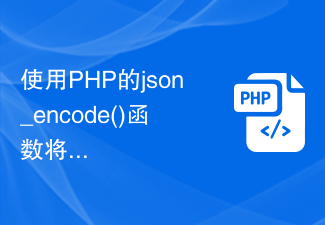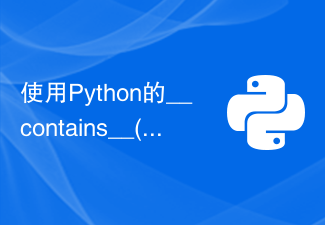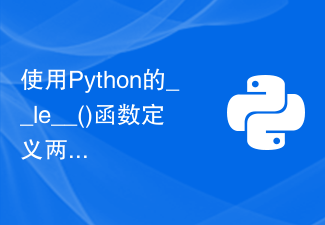Object-oriented basics of php code 1
This article is not suitable for beginners. Those who have a certain understanding of PHP can read it to supplement or review some of the object-oriented features of PHP.
1. What is object-oriented?
Let me introduce a question. Although I know a little bit about it, I still feel that I still can’t solve it. I can only say that everything is regarded as an object. Only in development can you realize what object-oriented is. Just saying it is in vain, but because PHP is mostly used in web development, so it can run well even if it is not object-oriented. When I was doing C++ development before, I designed a functional interface for you. When you see this interface, the first thing you do is to cut it like an artist. Cut it into objects one by one, then determine the relationship between each object, and finally develop it. This idea is everywhere.
What is a class? What is an object?
A class is an abstraction of a set. What set is it? Is a collection of objects with similar properties and operations.
An object is a specific instance of a class.
When I graduate, I may recite it to the interviewer, but now, although my understanding is still as vulgar as the sentences in the book, at least I no longer need to rely on my brain cells to express these two definitions.
Class structure in 2.php
Classes in PHP are also access control characters, and they also have attributes and methods.
class Person {
private $name = "PersonName";
public static $gender = "PersonGender";
public function test(){
echo $this->name, '<br />';
}
};
The name of the constructor is __construct. I want to emphasize the following points in the constructor:
1. PHP will not automatically call the constructor of your parent class when instantiating a subclass like other languages (C++ or Java). In PHP, you need to manually call the constructor of the parent class, which involves inheritance. , you can take a look at inheritance first.
class Person{
public funciton __construct(){
echo 'Person construct<br />';
}
};
class Teacher extends Person{
public function __construct(){
//parent::__construct();
echo 'Teacher construct<br />';
}
};
$t1 = new Teacher; //生成Teacher对象Run results:
Teacher construct
If you want to initialize some data of the parent class when generating a subclass, you need to manually call the constructor of the parent class and just open the comment line.
2. You cannot write two constructors with different parameters in a class.
This involves some regulations in PHP. In other languages, the following writing is correct:
class Person{
public funciton __construct(){
echo 'Person construct<br />';
}
public function __construct($param){
echo 'Person with param construct<br />';
}
};However, it is not allowed in PHP. The root cause is that PHP is a weak language type and is not very sensitive to type restrictions. It then provides __call and func_get_args function mechanisms, so it can be implemented in the following way:
class Person{
public function __construct(){
$param = func_get_arg(); //获取参数数据
$param_num = func_num_args(); //获取参数个数
if($param_num == 0){
}else if($param_num == 1){
if(is_array($param[0])){
//...
}
}else{
//...
}
}
};3. Destructor
The destructor is a function that is automatically called when the instance object ends. You can write a statement to release the memory to draw a perfect end to the death of the instance. This is the same as the construction. It is necessary when there is an inheritance relationship. Manually call the destructor of the parent class. There is only one destructor in a class.
4. Control access characters
public: Public accessor, this property or method can be accessed within the class, within the subclass, and outside the class.
protected: Protected accessor, this property or method can only be accessed within the class and its subclasses, and cannot be accessed outside the class.
private: Private accessor, which can only be accessed within this class. It is private stuff of this class. It cannot be inherited, cannot be overloaded, and cannot be accessed by anyone.
5. Magic methods __get and __set
The functions of these two methods: an accessor for protected and private property access, which can verify the security and rationality of data received from outside the class.
The __set method receives two parameters, the first is the attribute name, and the second is the new value to be assigned.
The __get method receives one parameter, the attribute name.
1. Public attributes can provide services for modifying attributes outside the class. Therefore, for public attributes, the __get and __set processes will not be followed.
class D{
public $name = 'D name';
protected $gender = 'male';
private $age = 18;
public function __set($name, $value){
echo '__set<br />';
//if(in_array($name, ['name', 'gender', 'age']))
$this->$name = $value;
}
public function __get($name){
echo '__get<br />';
//if(!in_array($name, ['name', 'gender', 'age'])) return NULL;
return $this->$name;
}
};运行结果:
new D name //name为public属性,不会走get和set __set __get new D gender __set __get new D age
2. We can also add the function of data verification, and verification can be performed by opening the comments.
3. The two methods must have public access, otherwise an error will be prompted. We can think from the functions of these two functions, and it is not difficult to imagine why public access control is needed.
6. Inheritance
Finally, you have the feature that can make your chrysanthemum bloom. Without inheritance, all classes are rubbish. Because of inheritance,... problems are coming in waves... Let Let’s take a closer look at this inheritance feature.
Let’s not talk about inheritance. There is a small example of inheritance at the beginning of the article.
What problems will occur if there is inheritance? Think about it, if B inherits A... It's really unimaginable...
1. Constructor, don’t worry, it has nothing to do with inheritance. It is equivalent to the constructor in two classes, but there is a parent-child relationship anyway. You can’t do things too well. So, as mentioned above, If necessary, you can manually call the constructor of the parent class. You can see the example above.
2. One-way inheritance. Inheritance is one-way. Subclasses can inherit from parent classes, but parent classes cannot inherit features from subclasses. Example:
class A{
public $attr1;
public function oper1(){
}
};
class B extends A{
public $attr2;
public function oper2(){
}
};
//子类可以继承父类
$b = new B;
$b->oper1();
$b->attr1 = 'attr1 value';
$b->oper2();
$b->attr2 = 'attr2 value';
//父类不能继承子类
$a = new A;
$a->oper2();//出错
$a->attr1();//出错3. Overloading. When it comes to overloading in PHP, it is very awkward, because its overloading is called overwrite in other languages. I am still used to calling this feature overwriting, so you can feel free to use it.
public重载:
class E{
public $attr1 = 'E attr1 value';
public function oper1(){
echo 'E oper1<br />';
echo 'attr1 value = ', $this->attr1, '<br />';
}
};
class F extends E{
public $attr1 = 'F attr1 value';
public function oper1(){
//parent::oper1();
echo 'F oper1<br />';
echo 'attr1 value = ', $this->attr1, '<br />';
}
};
$f = new F;
$f->oper1();
运行结果:
F oper1
attr1 value = F attr1 value
F继承了E并且重写了E的attr1和oper1,因此,在调用oper1时,$this->attr1显示F attr1 value,如果打开注释parent::oper1调用父类的Oper1方法,运行结果如下:
E oper1
attr1 value = F attr1 value //attr1属性已经被子类重写的attr1属性覆盖
F oper1
attr1 value = F attr1 value
可以看出子类重写父类的属性和方法后,会覆盖父类相应的属性和方法。
private重载
class E{
private $attr1 = 'E attr1 value';
public function oper1(){
echo 'E oper1<br />';
echo 'attr1 value = ', $this->attr1, '<br />';
}
};
class F extends E{
public $attr1 = 'F attr1 value';
public function oper1(){
parent::oper1();
echo 'F oper1<br />';
echo 'attr1 value = ', $this->attr1, '<br />';
}
};
$f = new F;
$f->oper1();以上代码只变动了一处地方,就是把父类$attr1的访问属性变成private,那重载机制如何执行呢?先看运行结果:
E oper1
attr1 value = E attr1 value //父类私有的属性
F oper1
attr1 value = F attr1 value
之前我们说过,private属性和方法子类是继承不了的,这种情况,遵循一个原则:
private属性在那个类里调用的,就显示哪个类里的属性值。
示例中的parent::oper1方法调用的是E类的oper1方法,在E的oper1方法内又调用了$this->attr1,attr1是private并没有被子类继承,因此,调用的就是类E里的attr1属性值。
protected重载与public重载一致
类属性的继承
class G{
public static $attr1 = 'G attr1 value';
public function oper1(){
echo 'G oper1<br />';
echo 'attr1 value = ', self::$attr1, '<br />';
}
};
class H extends G{
public static $attr1 = 'H attr1 value';
public function oper1(){
parent::oper1();
echo 'H oper1<br />';
echo 'attr1 value = ', self::$attr1, '<br />';
}
};
$h = new H;
$h->oper1();
运行结果:
G oper1
attr1 value = G attr1 value
H oper1
attr1 value = H attr1 value
其实不管G类的attr1属性是public还是private,结果都一样。
个人是这么理解的,类属性可以继承,但谈不上重载,那关于子类调用父类的属性也有一规则:
self或者parent只代表本类,因此,根据这一原则可以断定,属性的值一定是本类属性的值,与子类无关。(特殊情况时php的静态延迟加载机制)。
七.静态延迟加载
既然已经提到了静态延迟加载,就趁热打铁讲一下,H和G的例子大家已经看了,那我就是想要在子类中调用父类的东东怎么办?静态延迟加载就是解决这个问题,请看两个示例:
示例1:
还是H和G类的例子
class G{
public static $attr1 = 'G attr1 value';
public function oper1(){
echo 'G oper1<br />';
echo 'attr1 value = ', static::$attr1, '<br />';
}
};
class H extends G{
public static $attr1 = 'H attr1 value';
public function oper1(){
parent::oper1();
echo 'H oper1<br />';
echo 'attr1 value = ', self::$attr1, '<br />';
}
};
$h = new H;
$h->oper1();运行结果:
G oper1
attr1 value = H attr1 value
H oper1
attr1 value = H attr1 value
上面代码只是将G类里的self::$attr1改写成了static::$attr1,运行结果就不一样了
示例2:
class I {
public static function who(){
echo __CLASS__, '<br />';
}
public static function test(){
static::who();
}
};
class J extends I{
public static function who(){
echo __CLASS__,'<br />';
}
};运行结果:
J
通过这两个例子,可以好好的领悟一下static的静态延迟绑定。
写的有点多,主要是因为一牵扯继承就停不下来....面向对象还有一些只是点,后面有时间再补上吧...谢谢,如若有错误的地方,敬请大家指出,随时更正,谢谢!!
 使用PHP的json_encode()函数将数组或对象转换为JSON字符串Nov 03, 2023 pm 03:30 PM
使用PHP的json_encode()函数将数组或对象转换为JSON字符串Nov 03, 2023 pm 03:30 PMJSON(JavaScriptObjectNotation)是一种轻量级的数据交换格式,已经成为Web应用程序之间数据交换的常用格式。PHP的json_encode()函数可以将数组或对象转换为JSON字符串。本文将介绍如何使用PHP的json_encode()函数,包括语法、参数、返回值以及具体的示例。语法json_encode()函数的语法如下:st
 源码探秘:Python 中对象是如何被调用的?May 11, 2023 am 11:46 AM
源码探秘:Python 中对象是如何被调用的?May 11, 2023 am 11:46 AM楔子我们知道对象被创建,主要有两种方式,一种是通过Python/CAPI,另一种是通过调用类型对象。对于内置类型的实例对象而言,这两种方式都是支持的,比如列表,我们即可以通过[]创建,也可以通过list(),前者是Python/CAPI,后者是调用类型对象。但对于自定义类的实例对象而言,我们只能通过调用类型对象的方式来创建。而一个对象如果可以被调用,那么这个对象就是callable,否则就不是callable。而决定一个对象是不是callable,就取决于其对应的类型对象中是否定义了某个方法。如
 使用Python的__contains__()函数定义对象的包含操作Aug 22, 2023 pm 04:23 PM
使用Python的__contains__()函数定义对象的包含操作Aug 22, 2023 pm 04:23 PM使用Python的__contains__()函数定义对象的包含操作Python是一种简洁而强大的编程语言,提供了许多强大的功能来处理各种类型的数据。其中之一是通过定义__contains__()函数来实现对象的包含操作。本文将介绍如何使用__contains__()函数来定义对象的包含操作,并且给出一些示例代码。__contains__()函数是Pytho
 使用Python的__le__()函数定义两个对象的小于等于比较Aug 21, 2023 pm 09:29 PM
使用Python的__le__()函数定义两个对象的小于等于比较Aug 21, 2023 pm 09:29 PM标题:使用Python的__le__()函数定义两个对象的小于等于比较在Python中,我们可以通过使用特殊方法来定义对象之间的比较操作。其中之一就是__le__()函数,它用于定义小于等于比较。__le__()函数是Python中的一个魔法方法,并且是一种用于实现“小于等于”操作的特殊函数。当我们使用小于等于运算符(<=)比较两个对象时,Python
 详解Javascript对象的5种循环遍历方法Aug 04, 2022 pm 05:28 PM
详解Javascript对象的5种循环遍历方法Aug 04, 2022 pm 05:28 PMJavascript对象如何循环遍历?下面本篇文章给大家详细介绍5种JS对象遍历方法,并浅显对比一下这5种方法,希望对大家有所帮助!
 Python中如何使用getattr()函数获取对象的属性值Aug 22, 2023 pm 03:00 PM
Python中如何使用getattr()函数获取对象的属性值Aug 22, 2023 pm 03:00 PMPython中如何使用getattr()函数获取对象的属性值在Python编程中,我们经常会遇到需要获取对象属性值的情况。Python提供了一个内置函数getattr()来帮助我们实现这个目标。getattr()函数允许我们通过传递对象和属性名称作为参数来获取该对象的属性值。本文将详细介绍getattr()函数的用法,并提供实际的代码示例,以便更好地理解。g
 使用Python的isinstance()函数判断对象是否属于某个类Aug 22, 2023 am 11:52 AM
使用Python的isinstance()函数判断对象是否属于某个类Aug 22, 2023 am 11:52 AM使用Python的isinstance()函数判断对象是否属于某个类在Python中,我们经常需要判断一个对象是否属于某个特定的类。为了方便地进行类别判断,Python提供了一个内置函数isinstance()。本文将介绍isinstance()函数的用法,并提供代码示例。isinstance()函数可以判断一个对象是否属于指定的类或类的派生类。它的语法如下
 PHP代码封装技巧:如何使用类和对象封装可重复使用的代码块Jul 29, 2023 pm 11:19 PM
PHP代码封装技巧:如何使用类和对象封装可重复使用的代码块Jul 29, 2023 pm 11:19 PMPHP代码封装技巧:如何使用类和对象封装可重复使用的代码块摘要:在开发中,经常遇到需要重复使用的代码块。为了提高代码的可维护性和可重用性,我们可以使用类和对象的封装技巧来对这些代码块进行封装。本文将介绍如何使用类和对象封装可重复使用的代码块,并提供几个具体的代码示例。使用类和对象的封装优势使用类和对象的封装有以下几个优势:1.1提高代码的可维护性通过将重复


Hot AI Tools

Undresser.AI Undress
AI-powered app for creating realistic nude photos

AI Clothes Remover
Online AI tool for removing clothes from photos.

Undress AI Tool
Undress images for free

Clothoff.io
AI clothes remover

AI Hentai Generator
Generate AI Hentai for free.

Hot Article

Hot Tools

VSCode Windows 64-bit Download
A free and powerful IDE editor launched by Microsoft

SublimeText3 Mac version
God-level code editing software (SublimeText3)

Zend Studio 13.0.1
Powerful PHP integrated development environment

mPDF
mPDF is a PHP library that can generate PDF files from UTF-8 encoded HTML. The original author, Ian Back, wrote mPDF to output PDF files "on the fly" from his website and handle different languages. It is slower than original scripts like HTML2FPDF and produces larger files when using Unicode fonts, but supports CSS styles etc. and has a lot of enhancements. Supports almost all languages, including RTL (Arabic and Hebrew) and CJK (Chinese, Japanese and Korean). Supports nested block-level elements (such as P, DIV),

SAP NetWeaver Server Adapter for Eclipse
Integrate Eclipse with SAP NetWeaver application server.







